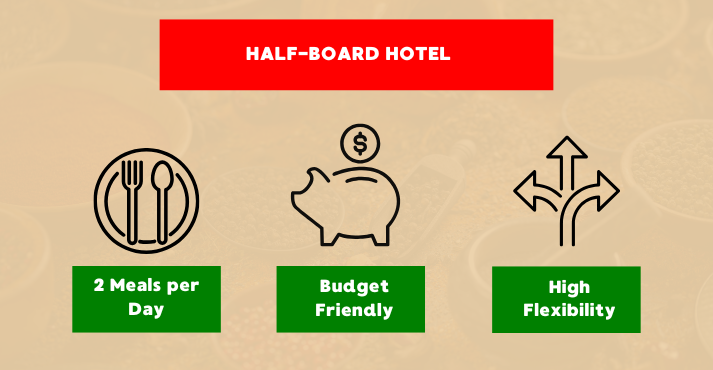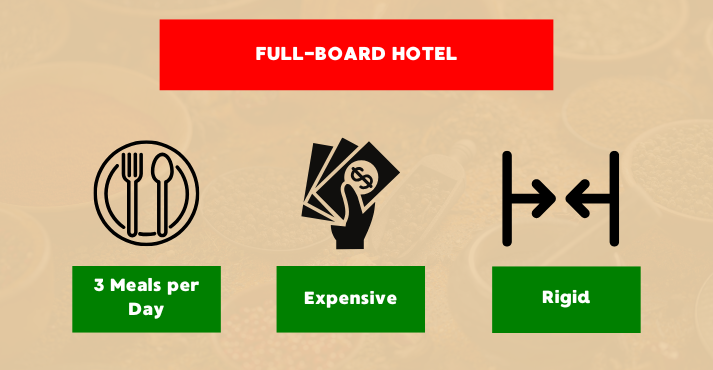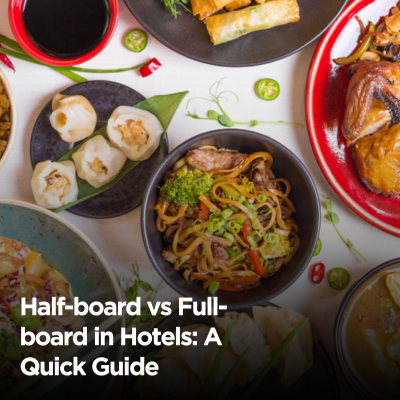Every journey begins with a choice—not just of destination, but of experience. For many travelers, the trip anticipation includes imagining leisurely breakfasts, aesthetic dinners, and perhaps the joy of discovering local cuisine.
The hotel industry returned to life after COVID-19, and the global hotel occupancy rate was 68% in the summer of 2024, rebounding back to pre-COVID levels. If you are traveling to your favorite destination in the upcoming months, the question arises: which hotel board package is best, half-board vs. full-board?
Some prefer the freedom of a breakfast-only plan, leaving their days open for culinary adventures and hunting for street food and local cuisine outside of their hotel lobby.
Others opt for half-board, balancing hotel comfort with the frequent chance of dining out. For those who prefer a worry-free escape, full board ensures every meal is cared for, allowing especially busy business travelers to savor the moment without a second thought.
This blog will help you decide which plan makes more sense and aligns well with your preferences: half-board vs. full-board. Let’s explore the difference between half-board and full-board hotels to understand these 2 tiers.
What is a Half-Board Package?

A half-board Package in a hotel includes two daily meals (typically breakfast and a choice between lunch or dinner). Most hotels default to dinner as the second meal, but some allow guests to choose between lunch and dinner.
What does half-board mean for your travel experience?
Half-board is ideal for travelers who spend most of the day outside the hotel but prefer a guaranteed meal upon their return. It also suits guests who want to avoid the hassle of finding restaurants for every meal while still experiencing local food options for lunch or dinner.
This arrangement provides a structured dining experience while allowing you to explore local cuisine for your remaining meal.
You can opt for breakfast (before leaving) and dinner after arriving at your hotel after a long day out. While you can enjoy and experiment with the lunch at your preferred food destinations.
What Do You Get with Half-Board?
- Breakfast – Usually a buffet with various options, including hot and cold dishes, beverages, and pastries.
- Lunch or Dinner – Often served as a buffet or a set menu with limited choices. Some hotels allow guests to take their meal as a takeaway if they plan to be out during the day.
- Beverages – Do you get drinks with half-board? Yes, you get drinks such as coffee, tea, and juice, typically included with breakfast, while drinks during other meals are optional and may come at an additional cost.
Different types of hotels and regions may offer variations, for instance:
- Some upscale resorts provide themed dinner nights or à la carte options instead of buffets.
- Certain hotels may offer drink packages to complement meals.
- Resorts in remote areas may limit meal choices due to fewer dining alternatives nearby.
Regarding half-board culture in Southeast Asia, many beachfront resorts in Bali, Thailand, and the Maldives offer half-board packages tailored to tourists.
These luxury resorts in your favorite travel destinations provide a half-board package with breakfast and a set menu dinner at its in-house restaurant, featuring a mix of local and international dishes.
What is a Full-Board Package?

A full-board package in a hotel includes three main meals daily: breakfast, lunch, and dinner. This arrangement ensures that guests have all their meals covered within the hotel, making it a convenient option for those who prefer not to worry about finding restaurants or planning their dining schedule.
What does full-board mean for your travel experience?
The full board is ideal for guests who prefer hassle-free and all-inclusive retreats, mainly in high-end resorts and beach hotels. This is particularly helpful in scenarios where:
- You are on a business trip and don’t have much time to explore outside food options.
- Dining options outside the hotel may be limited or far from the vicinity where you are staying.
This package is popular among families, retirees, businessmen, and travelers looking for budget predictability, as it reduces unexpected food costs. It’s perfect for those who want a stress-free vacation with all meals taken care of while enjoying the hotel amenities and surroundings.
What Do You Get with Full-Board?
- Breakfast – Typically served as a buffet, featuring a variety of hot and cold dishes, pastries, cereals, and beverages such as coffee, tea, and juice.
- Lunch & Dinner – These are usually buffet-style or set menus with a selection of dishes. Some hotels allow guests to request packed meals if they plan to be out during the day.
- Beverages – Drinks are often only included with breakfast, while lunch and dinner beverages may be charged separately unless the hotel offers a drinks package.
Some hotels may offer:
- Upgrades to à la carte restaurants with meal credits.
- Customizable meal plans to allow guests to swap meals for room service or takeaways.
- Drinks packages for unlimited soft drinks or alcoholic beverages during meals.
Remember, if you opt for a full-service hotel, you can expect a range of other facilities and luxuries included in a high-end booking package.
If you are traveling in Southeast Asia, you can find resorts that cater to full-board guests. In Dubai, Thailand, Malaysia, and Singapore, the resorts and hotels offer a full-board package that includes breakfast, lunch, and dinner with themed buffets and live cooking stations.
Half-Board vs. Full-Board – What are the Differences
The main difference between half-board and full-board arises from the levels of dining coverage, flexibility, and pricing.
But it adds up to other factors that you must consider as well. The table below compares half-board vs. full-board hotel packages to help you select the best option based on your budget, itinerary, and dining preferences.
| Category | Half-Board (HB) | Full-Board (FB) |
|---|---|---|
| Number of Meals | 2 meals (Breakfast + Lunch/Dinner) | 3 meals (Breakfast, Lunch, and Dinner) |
| Dining Flexibility | High – Freedom to explore local dining options | Low – All meals must be taken at the hotel |
| Cost | Lower – More budget-friendly | Higher – Includes all meals but may save money in expensive areas |
| Best Suited For | Tourists who explore during the day, food enthusiasts | Families, resort guests, or travelers staying at the hotel |
| Beverages | Usually only included at breakfast | Usually only included at breakfast |
| Meal Format | Buffets or set menus | Buffets or set menus |
| Takeaway Option | Some hotels offer packed meals for outings | Some hotels allow meal takeaways for excursions |
| Best Locations | Cities, destinations with many restaurants | Resorts, remote areas, expensive tourist spots |
| Who Should Choose It? | Travelers who enjoy local cuisine & flexibility | Guests who prefer a stress-free, all-inclusive dining experience |
Let’s go deep into these crucial factors to discuss the breakdown in detail.
1. Number of Meals
| Meal Plan | Meals Included | Drinks Included? |
|---|---|---|
| Half Board (HB) | Breakfast + One Main Meal (Lunch or Dinner) | Usually only with breakfast |
| Full Board (FB) | Breakfast + Lunch + Dinner | Usually only with breakfast |
- Half-board covers two meals per day: breakfast and a choice between lunch or dinner. Most hotels default to dinner, but some offer flexibility.
- Full-board includes all three main meals, covering breakfast, lunch, and dinner, ensuring guests never have to worry about where to eat.
2. Flexibility
| Feature | Half Board | Full Board |
|---|---|---|
| Dining Freedom | High – Guests can eat one meal outside the hotel | Low – All meals are within the hotel |
| Itinerary Adaptability | Ideal for travelers who explore during the day | Best for those who spend most time at the hotel |
| Dining Options | Usually a buffet or set menu | Usually buffet-style or set menu |
- Half-board is perfect for those who enjoy trying local cuisine or sightseeing. Since lunch is not included, guests can explore restaurants, street food, or cafés.
- Full-board provides structured dining and is best for those who prefer staying at the hotel, such as families with children or guests at resorts with limited external dining options.
3. Cost Differences
| Feature | Half Board | Full Board |
|---|---|---|
| Price | Lower | Higher |
| Additional Expenses | Guests pay for one meal outside | Meals are covered, but drinks may cost extra |
| Value for Money | Good for flexible travelers | Cost-effective for those who dine at the hotel |
- Half-board is more budget-friendly, as guests only pay for two meals instead of three.
- Full-board is generally more expensive but can be a good deal for those who eat all meals at the hotel.
*In tourist-heavy destinations, restaurant prices can be high, making full-board a more economical choice for guests who don’t want to spend extra on dining.
Pro Tip: Compare meal costs outside the hotel with the full-board price to decide whether the extra cost is worth it.
If you are a budget traveler and want to save extra pennies, consider opting for a budget-friendly, limited-service hotel without unnecessary frills.
4. Best Suited For
| Traveler Type | Half Board | Full Board |
|---|---|---|
| Sightseeing Tourists | Best Choice | Less ideal |
| Families with Children | May be suitable | Best Choice |
| Beach/Resort Guests | Good for flexibility | Best Choice |
| Budget-Conscious Travellers | More affordable | Higher cost but may be valuable |
- Half-board is ideal for tourists who spend the day exploring, as they won’t feel restricted to hotel meals.
- Full-board suits families with kids, business travelers, and resort guests, removing the need to find restaurants and ensuring all meals are cared for.
*half-board is better if you plan to explore and eat out. If you want complete convenience and meal coverage, go for full-board.
Additional Considerations
Below are some additional aspects that you must keep in mind to get the most out of your hotel budget:
Beverage Inclusions
- Most half-board and full-board packages exclude drinks, except for tea, coffee, and juice at breakfast.
- Some hotels offer drink packages with soft drinks or alcoholic beverages.
Takeaway & Meal Swaps
- Some hotels allow meal takeaways for guests who will be out during the day.
- Luxury resorts may provide options to swap meals or credit meal allowances for à la carte dining.
Pros and Cons of Half-Board and Full-Board
When choosing between half-board and full-board meal plans, it’s crucial to understand the advantages and limitations of each.
While both offer convenient options for meals during your stay, they cater to different travel styles, budgets, and preferences. Here’s a deeper look into the pros and cons of each option:
Half-Board Pros
1. Flexibility
Half-board provides flexibility when it comes to your dining schedule. With only breakfast and one main meal (usually dinner or lunch) included, you are free to explore local restaurants and taste regional delicacies.
This is ideal for travelers who want to enjoy authentic local cuisine or venture out to try different food spots outside the hotel.
If you’re planning to spend your days sightseeing, going on excursions, or visiting local attractions, half-board ensures you don’t have to spend your entire day at the hotel. Having dinner or lunch taken care of allows you to explore the area and enjoy the city or countryside.
2. More Affordable
Half-board is generally more budget-friendly than full-board. Since it includes fewer meals (only breakfast and either lunch or dinner), the overall cost is usually lower, making it a good option for budget-conscious travelers.
For those who don’t mind spending time outside the hotel and don’t need every meal included, half-board can provide excellent value for money.
If you’re not someone who needs three meals a day at the hotel, half-board provides a lighter, more cost-effective option. You can enjoy a substantial breakfast, and then you’re free to explore local eateries for lunch, or return for a hotel dinner.
3. Local Exploration
If you enjoy exploring the culinary scene of the place you’re visiting, half-board gives you the freedom to try out street food, café dining, or dinner at a local restaurant. You can enjoy the flexibility of having a hearty breakfast at the hotel and still discover the area’s food culture during your free meals.
Half-Board Cons
1. Limited Meals
The main drawback of half-board is that it only includes two meals a day—breakfast and one other (typically dinner or lunch). This limits your meal options to just these two, and you may end up spending more money outside the hotel if you want additional meals or snacks.
For some guests, especially those staying at resorts or remote locations, half-board may feel like it doesn’t provide enough meals at the hotel. You might find yourself needing to go out for lunch or snacks, adding extra costs or inconvenience.
2. No Drinks Included
Another potential disadvantage of half-board is that drinks, especially alcoholic ones, are typically not included with meals.
Some hotels may provide juice or tea/coffee at breakfast, but wine, beer, or soft drinks at dinner often come at an additional cost. If you’re someone who enjoys a drink with dinner, this can add to your overall expenses.
Full-Board Pros
1. All Meals Included
One of the biggest advantages of full-board is that all three main meals—breakfast, lunch, and dinner—are included in the package. You don’t have to worry about where or what to eat throughout the day.
Whether you’re at a resort or a hotel, you’ll be provided with a set meal plan for all your dining needs, making it hassle-free and straightforward.
Full-board is especially beneficial for families or guests staying at a hotel for an extended period. With all meals included, you don’t have to worry about searching for restaurants or meal options every day.
This is particularly convenient for families with children, who may prefer the consistency and ease of having all meals provided in one place.
With full-board, the price of all meals is typically bundled into the package, so there’s no need to think about extra food-related expenses. This can make budgeting for your trip easier, as you don’t need to factor in additional costs for each meal.
2. Stress-Free Experience
Full-board offers peace of mind for those who want a stress-free holiday. You won’t need to plan meals, find restaurants, or worry about extra costs for food. The meals are all covered under one package, which is perfect for those who want everything sorted out for them during their stay.
For those who appreciate having set meal times and consistent dining options, full-board provides a level of comfort and reliability, ensuring that you’re always well-fed without surprises.
3. Best for Remote Locations
If you’re staying in a location where there are limited or expensive dining options, full-board is the most convenient and economical choice. Resorts, hotels in remote areas, or places with fewer local restaurants can benefit from full-board, as it eliminates the hassle of searching for food outside the hotel.
Cons of Full-Board
1. Higher Upfront Cost
Full-board packages generally cost more upfront than half-board. Since they include all three main meals, they are priced higher, making it a more expensive option for travelers who might not need every meal provided.
While the added cost can be justified if you plan to eat all your meals at the hotel, it may feel like an extra expense for those who are looking to explore local dining.
2. Less Flexibility
One downside of full-board is that you’re limited to the hotel’s dining options. There’s less flexibility to try out local restaurants, street food, or cafes since all meals are provided within the hotel. For travelers who enjoy tasting local cuisine outside the hotel, this can feel restrictive.
Full-board meals are set, which means you might miss out on spontaneous dining experiences. This structure could feel too rigid for those who prefer a more relaxed, flexible approach to their meals during travel.
Half-board vs. Full-board – Which One Should You Choose?
When deciding between half-board vs. full-board, consider all the factors like your travel itinerary, budget, dining plans, and hotel location. Each package offers distinct advantages depending on how you spend your time and money.
Travel Itinerary
Your daily schedule plays a key role in choosing the right meal plan.
- Half-board is the better choice if you plan to explore the city, visit attractions, or take excursions. You’ll have breakfast at the hotel and be free to enjoy local restaurants for lunch before returning for dinner.
- If you’re staying at a beach resort, spa retreat, or mountain lodge, full-board ensures all meals are covered, providing convenience and ease without needing to find dining options elsewhere.
Budget Consideration
On the monetary side, your budget can significantly impact which package makes the most sense.
- Half-board is more budget-friendly since you only pay for two meals daily. If you’re traveling to a place with affordable restaurants, this option lets you control your spending.
- Full-board helps avoid unexpected meal expenses but requires a higher upfront cost. It’s best suited for families or travelers who want a fixed food budget without worrying about additional restaurant costs.
Checking for hotel rate parity while booking a hotel through the official website or 3rd party platforms is always recommended.
Hotel Location
Similarly, where you’re staying can impact whether half-board vs. full-board is the better choice.
- Half-board makes sense in cities with numerous affordable dining options since you can easily find budget-friendly meals outside the hotel.
- Full-board can be more cost-effective in remote locations, resorts, or expensive tourist areas, as food options outside the hotel may be limited or overpriced.
FAQs
Which meal plan is best for families?
For families, Full Board is often the best choice. It provides all three main meals (breakfast, lunch, and dinner), making it convenient for families, especially those with young children.
Does half board include drinks?
Half-Board typically includes only breakfast and one main meal (lunch or dinner), but drinks are usually not included with meals, except for breakfast. In most cases, you’ll need to purchase drinks separately, including during lunch or dinner.
Is half-board worth it for short stays?
Yes, half-board can be a great option for short stays, as it allows flexibility to explore the destination for lunch while still having dinner covered at the hotel.
Can I eat outside the hotel with full board?
While full-board ensures all meals at the hotel, some hotels may offer flexibility, such as allowing you to take lunch or dinner off-site in certain cases, especially at resorts with multiple dining options.
Conclusion
Now you understand which meal plan to pick – half-board or full-board. Here’s the bottom line:
- Choose half-board if you plan to explore and eat out.
- Choose full-board if you want a stress-free experience with all meals included.
You can make an informed choice that best suits your travel needs by considering your itinerary, budget, food preferences, and hotel location, including other aspects relevant to the country you visit, like travel-heavy destination, remote location, etc.













